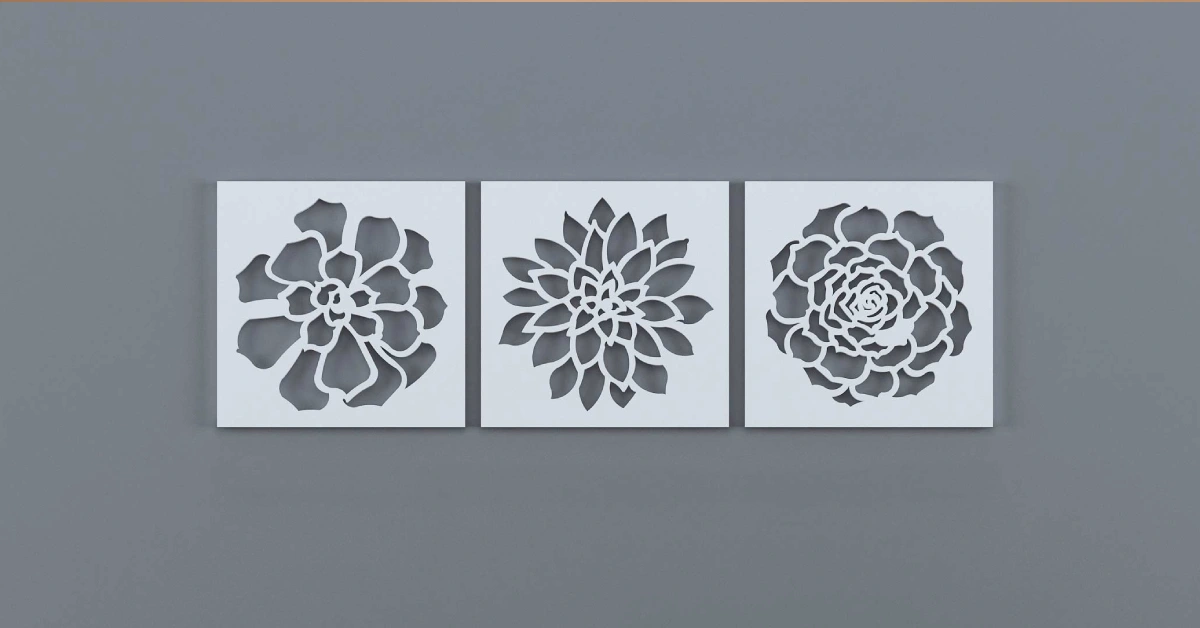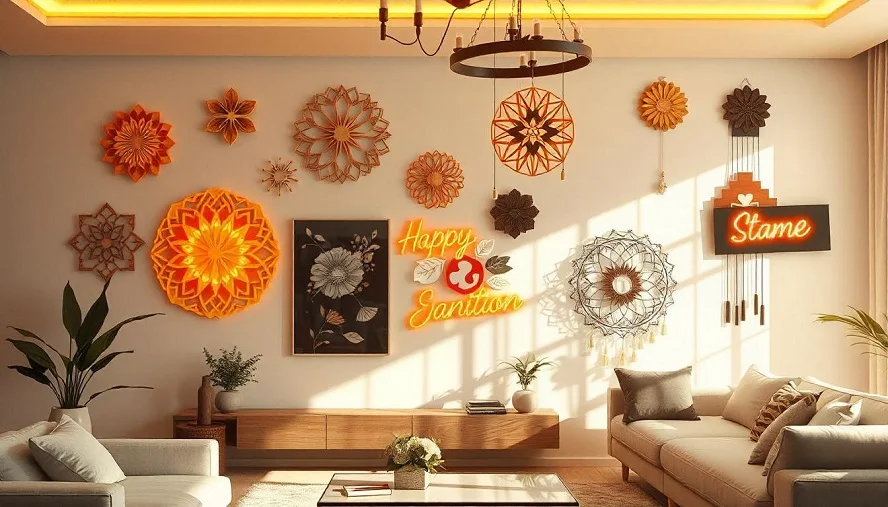Laser cutting technology transforms ordinary materials into stunning decorative pieces that elevate any room. With precision cutting capabilities and endless design possibilities, laser-cut decor artworks offer a perfect blend of craftsmanship and personalization. These projects range from simple wall hangings to complex three-dimensional sculptures, making them suitable for both beginners and experienced creators.
10 Creative Ideas For Artworks
1. Geometric Wall Art
Geometric patterns deliver timeless appeal and instantly modernize any space. Create multi-layered geometric compositions by cutting intricate hexagons, triangles, and abstract forms from birch plywood, acrylic sheets, or aluminum panels. The Maillard Style trend of 2025 emphasizes earthy brown tones and low-saturation warm shades, making natural wood cuts particularly popular for autumn and winter aesthetics.
Arrange the pieces in asymmetrical clusters or symmetrical grids to create visual rhythm on your walls. The precision of laser cutting allows for perfect interlocking pieces that create stunning shadow effects when mounted at varying depths.
2. Floral Hanging Mobiles
Transform lightweight basswood or specialty cardstock into delicate botanical mobiles that bring organic movement to your decor. Cut intricate leaf patterns, flower petals, and vine motifs that cascade gracefully from ceiling fixtures or wall mounts.
Layer different wood species like maple and walnut to create natural color variations without paint or stain. These kinetic sculptures respond to air currents, creating ever-changing shadow patterns that add life to static spaces.
3. Personalized Name Plaques
Custom typography and monogrammed designs remain top-selling items on platforms like Etsy, making personalized name plaques both meaningful and marketable. Cut names, family crests, or meaningful coordinates from MDF or acrylic to create conversation pieces for entryways, nurseries, or home offices.
Experiment with negative space lettering and shadow box mounting to add dimensional depth. Consider incorporating laser-engraved details like birth dates or special symbols within the letter forms themselves.
4. Intricate Room Dividers
Functional room dividers serve dual purposes as privacy screens and artistic focal points. Cut elaborate mandala patterns, geometric lattices, or nature-inspired designs into large panels of plywood or metal sheeting. These architectural elements work particularly well in open-concept spaces where you need to define areas without blocking light flow.
The interplay of cut-out patterns creates dynamic light and shadow effects that change throughout the day, making these pieces living artworks that evolve with natural lighting conditions.
5. 3D Paper Sculptures
Layered paper sculptures push the boundaries of traditional wall art by extending into three-dimensional space. Cut multiple identical patterns from heavyweight cardstock, then stack and offset them to create depth and volume.
These sculptural pieces work exceptionally well with backlighting, where LED strips placed behind the layers create dramatic illumination effects. The technique works particularly well for abstract geometric forms and stylized natural motifs.
6. Modern Clock Designs
Contemporary timepieces combine functionality with artistic expression. Cut sleek clock faces from colored acrylic or natural wood, incorporating negative space elements that allow wall color to show through as design features.
Choose contrasting materials for clock hands and numerals to create visual hierarchy. Oversized wall clocks measuring 24 inches or larger make particularly striking focal points in minimalist interiors.
7. Nature-Inspired Wall Hangings
Botanical motifs and wildlife silhouettes bring organic tranquility to indoor spaces. Cut detailed tree canopies, mountain ranges, or bird flight patterns from sustainable wood sources or powder-coated aluminum for outdoor durability.
Layer multiple cut pieces to create depth and dimension, with background elements in lighter tones and foreground details in darker materials. This technique mimics the natural layering found in forest scenes and landscape photography.
8. Customized Coasters and Trivets
Functional decor pieces protect surfaces while showcasing intricate design work. Cut personalized coasters from cork, leather, or hardwood featuring family monograms, geometric patterns, or botanical motifs.
Create coordinated sets with varying designs that share common elements like color palette or pattern style. These smaller projects serve as excellent introductory pieces for beginners learning laser cutting techniques.
9. Architectural Model Art
Miniature building facades and cityscape silhouettes celebrate architectural beauty. Create detailed replicas of famous landmarks, local buildings, or dream home designs by cutting precise building profiles from plywood or acrylic.
Mount these pieces on contrasting backgrounds to create dramatic shadow effects that emphasize architectural details. Group multiple buildings to create custom skyline compositions that represent meaningful places.
10. Whimsical Light Fixtures
Laser-cut lampshades and pendant lights transform ordinary lighting into artistic statements. Cut intricate patterns into cylindrical or conical shade forms that cast mesmerizing shadow patterns on surrounding surfaces.
Experiment with different materials for varying light diffusion effects – thin wood veneers create warm, filtered light while colored acrylics produce vibrant color effects. LED backlighting systems eliminate heat concerns while providing energy-efficient illumination.
Choosing the Right Laser Cutter

Selecting appropriate equipment determines both project possibilities and safety outcomes. Consider these essential factors when choosing laser cutting equipment:
- Material Compatibility: Different laser types handle specific materials effectively. CO₂ lasers excel with wood, acrylic, and fabric, while fiber lasers cut metals like stainless steel and aluminum with precision. Consider your primary material interests when selecting equipment.
- Power and Speed Specifications: Higher wattage units cut through thicker materials more efficiently, while lower power systems provide better control for intricate details on thin materials. Most home workshop applications work well with 40-80 watt CO₂ systems.
- Cutting Bed Dimensions: Bed size directly limits project scale possibilities. Standard home units offer 12″x20″ to 24″x36″ cutting areas, while commercial systems accommodate full sheet materials up to 48″x96″.
- Software Integration: Ensure compatibility with vector design programs like Adobe Illustrator, CorelDRAW, or LightBurn. Most modern systems include proprietary software, but third-party compatibility expands design workflow options.
- User-Friendly Controls: Intuitive interfaces reduce learning curves, especially for beginners. Look for systems with clear displays, simple calibration procedures, and comprehensive user manuals.
- Essential Safety Features: Modern laser systems must include protective enclosures, emergency stop mechanisms, and integrated ventilation systems. Proper ventilation and filtration systems remove hazardous fumes and particulate matter generated during cutting operations, while air assist systems prevent fires and improve cut quality.
Recent safety updates emphasize proper workspace ventilation – effective ventilation reduces particles and eliminates gaseous contaminants that pose respiratory hazards. Install dedicated exhaust systems that vent outside your workspace rather than recirculating filtered air.
Material Selection and Preparation
Choose materials based on both aesthetic goals and safety considerations. Avoid PVC, vinyl, and other chlorinated plastics that release toxic chlorine gas when cut. Safe material options include:
- Natural hardwoods and plywoods for warm, organic aesthetics
- Cast acrylics in various colors and finishes for modern, sleek appearances
- Food-safe cutting boards and bamboo sheets for functional kitchen items
- Genuine leather and cork sheets for textural variety
- Aluminum and stainless steel sheets for industrial or outdoor applications
Always verify material safety data sheets before cutting unknown materials to prevent dangerous fume exposure.
Contemporary trends favor sustainable material choices – earthy, brown-toned hues with low-saturation warm shades align with 2025’s Maillard Style aesthetic, making natural wood species particularly popular for current design preferences.
Design Software and File Preparation
Vector-based design files produce the cleanest cutting results. Create designs in Adobe Illustrator, CorelDRAW, or free alternatives like Inkscape. Set up files with separate layers for cutting lines, engraving areas, and scoring marks to streamline production workflow.
Use stroke weights of 0.001″ or hairline thickness for cutting paths – thicker lines may confuse the laser controller. Convert all text to outlines before finalizing files to prevent font substitution issues.
Consider kerf width (material removed by the laser beam) when designing interlocking pieces. Typical kerf widths range from 0.003″ to 0.015″, depending on material thickness and laser power settings.
Post-Processing and Finishing Techniques
Enhance your laser-cut pieces with professional finishing methods:
- Sand lightly with 220-grit paper to remove any residual burn marks or rough edges. Apply natural wood finishes like tung oil or Danish oil to enhance grain patterns while maintaining natural appearance.
- For painted finishes, use primer designed for your base material before applying topcoats. Spray finishes provide more even coverage than brush application on intricate cut patterns.
- Mount pieces using French cleats or keyhole hangers for secure wall mounting without visible hardware. Layer multiple pieces at varying distances from the wall to create dramatic shadow effects.
- Create professional lighting effects with LED strip lights placed behind translucent materials or spotlights positioned to enhance dimensional elements.
Laser-cut decor artworks offer unlimited creative possibilities for personalizing your living space. Whether you’re creating simple geometric patterns or complex architectural models, the precision and versatility of laser cutting technology make professional-quality results achievable for both hobbyists and serious craftspeople.
Start with simple projects to build confidence and gradually explore more complex techniques as you develop familiarity with your equipment and materials. The combination of digital design tools and precision cutting capabilities opens creative doors that traditional crafting methods simply cannot match.
Explore more inspiring decor ideas and expert tips to transform your space at HomeDecorToday—where style meets innovation!


